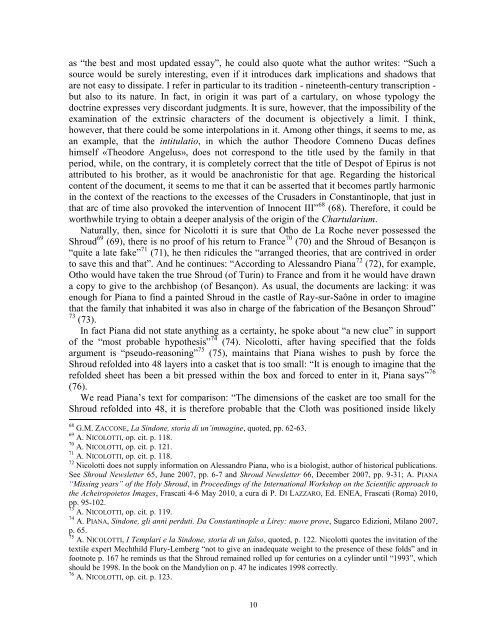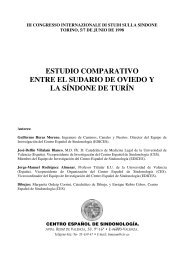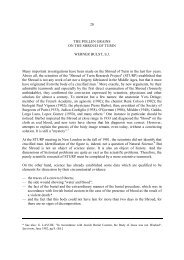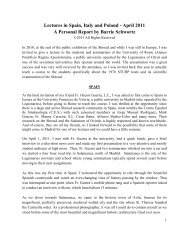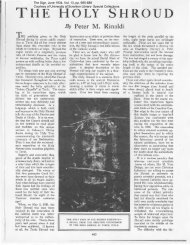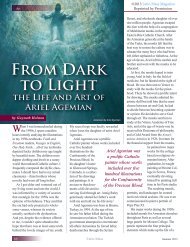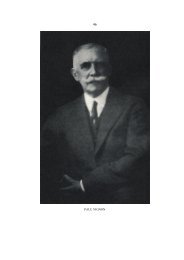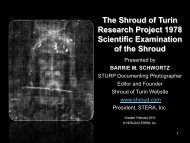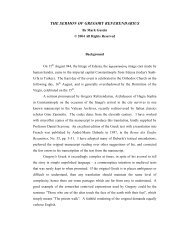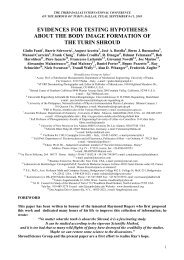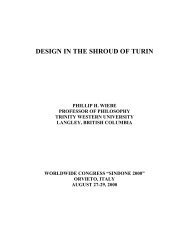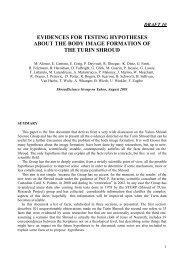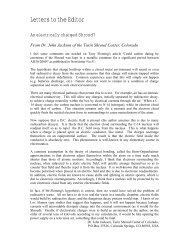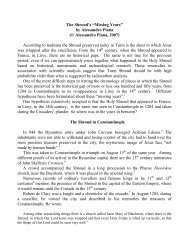BSTS Newsletter No. 74 - Part 8 - The Shroud of Turin Website
BSTS Newsletter No. 74 - Part 8 - The Shroud of Turin Website
BSTS Newsletter No. 74 - Part 8 - The Shroud of Turin Website
Create successful ePaper yourself
Turn your PDF publications into a flip-book with our unique Google optimized e-Paper software.
as “the best and most updated essay”, he could also quote what the author writes: “Such asource would be surely interesting, even if it introduces dark implications and shadows thatare not easy to dissipate. I refer in particular to its tradition - nineteenth-century transcription -but also to its nature. In fact, in origin it was part <strong>of</strong> a cartulary, on whose typology thedoctrine expresses very discordant judgments. It is sure, however, that the impossibility <strong>of</strong> theexamination <strong>of</strong> the extrinsic characters <strong>of</strong> the document is objectively a limit. I think,however, that there could be some interpolations in it. Among other things, it seems to me, asan example, that the intitulatio, in which the author <strong>The</strong>odore Comneno Ducas defineshimself «<strong>The</strong>odore Angelus», does not correspond to the title used by the family in thatperiod, while, on the contrary, it is completely correct that the title <strong>of</strong> Despot <strong>of</strong> Epirus is notattributed to his brother, as it would be anachronistic for that age. Regarding the historicalcontent <strong>of</strong> the document, it seems to me that it can be asserted that it becomes partly harmonicin the context <strong>of</strong> the reactions to the excesses <strong>of</strong> the Crusaders in Constantinople, that just inthat arc <strong>of</strong> time also provoked the intervention <strong>of</strong> Innocent III” 68 (68). <strong>The</strong>refore, it could beworthwhile trying to obtain a deeper analysis <strong>of</strong> the origin <strong>of</strong> the Chartularium.Naturally, then, since for Nicolotti it is sure that Otho de La Roche never possessed the<strong>Shroud</strong> 69 (69), there is no pro<strong>of</strong> <strong>of</strong> his return to France 70 (70) and the <strong>Shroud</strong> <strong>of</strong> Besançon is“quite a late fake” 71 (71), he then ridicules the “arranged theories, that are contrived in orderto save this and that”. And he continues: “According to Alessandro Piana 72 (72), for example,Otho would have taken the true <strong>Shroud</strong> (<strong>of</strong> <strong>Turin</strong>) to France and from it he would have drawna copy to give to the archbishop (<strong>of</strong> Besançon). As usual, the documents are lacking: it wasenough for Piana to find a painted <strong>Shroud</strong> in the castle <strong>of</strong> Ray-sur-Saône in order to imaginethat the family that inhabited it was also in charge <strong>of</strong> the fabrication <strong>of</strong> the Besançon <strong>Shroud</strong>”73 (73).In fact Piana did not state anything as a certainty, he spoke about “a new clue” in support<strong>of</strong> the “most probable hypothesis” <strong>74</strong> (<strong>74</strong>). Nicolotti, after having specified that the foldsargument is “pseudo-reasoning” 75 (75), maintains that Piana wishes to push by force the<strong>Shroud</strong> refolded into 48 layers into a casket that is too small: “It is enough to imagine that therefolded sheet has been a bit pressed within the box and forced to enter in it, Piana says” 76(76).We read Piana’s text for comparison: “<strong>The</strong> dimensions <strong>of</strong> the casket are too small for the<strong>Shroud</strong> refolded into 48, it is therefore probable that the Cloth was positioned inside likely68 G.M. ZACCONE, La Sindone, storia di un’immagine, quoted, pp. 62-63.69 A. NICOLOTTI, op. cit. p. 118.70 A. NICOLOTTI, op. cit. p. 121.71 A. NICOLOTTI, op. cit. p. 118.72 Nicolotti does not supply information on Alessandro Piana, who is a biologist, author <strong>of</strong> historical publications.See <strong>Shroud</strong> <strong>Newsletter</strong> 65, June 2007, pp. 6-7 and <strong>Shroud</strong> <strong>Newsletter</strong> 66, December 2007, pp. 9-31; A. PIANA“Missing years” <strong>of</strong> the Holy <strong>Shroud</strong>, in Proceedings <strong>of</strong> the International Workshop on the Scientific approach tothe Acheiropoietos Images, Frascati 4-6 May 2010, a cura di P. DI LAZZARO, Ed. ENEA, Frascati (Roma) 2010,pp. 95-102.73 A. NICOLOTTI, op. cit. p. 119.<strong>74</strong> A. PIANA, Sindone, gli anni perduti. Da Constantinople a Lirey: nuove prove, Sugarco Edizioni, Milano 2007,p. 65.75 A. NICOLOTTI, I Templari e la Sindone, storia di un falso, quoted, p. 122. Nicolotti quotes the invitation <strong>of</strong> thetextile expert Mechthild Flury-Lemberg “not to give an inadequate weight to the presence <strong>of</strong> these folds” and infootnote p. 167 he reminds us that the <strong>Shroud</strong> remained rolled up for centuries on a cylinder until “1993”, whichshould be 1998. In the book on the Mandylion on p. 47 he indicates 1998 correctly.76 A. NICOLOTTI, op. cit. p. 123.10


